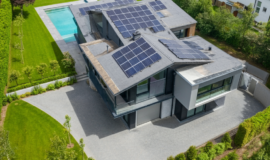Are Smart Grids the Future of the Electrical Power Network?
In the past years there has been a great advance in technology innovations and with that an immense increase in the demand of electrical energy that has become a challenge both for the energy production and energy distribution companies. This rising demand eventually resulted in forming a concept of a more reliable and efficient power grid which takes into consideration the environmental and energy sustainability concerns. This concept is known as the Smart Grid.
The Smart Grid introduces a two-way dialogue where electricity and information could be exchanged between a utility and its customers. It is a combination of new technology and tools, communications and automation which makes the grid more reliable, more efficient and greener. The Smart Grid enables renewable energy such as wind and solar to be integrated. The smart grid can easily replace the aging infrastructure of todays grid and we can better manage our electricity needs.
Smart grids use Smart Meters as a connection between the grid and your electricity needs and consumption. Unlike the traditional electrical meter, the Smart Meter can communicate with displays placed in your home which let you know how much energy you’re using and the time of day the energy was used. You can use this information to manage your electricity consumption and costs. Inside the Smart Home, a Home Area Network (HAN) connects Smart Appliances and other electric devices to a home management system. You can schedule your Smart Appliances to run at a certain time you want, resulting in lower energy bills. The Smart devices can be scheduled and controlled over the web.
The energy demands are constantly changing and so utilities must turn power plants on and off to match the consumers energy needs. The electricity cost depends on the time of day the energy is being delivered. The energy per kWh is more expensive when it’s delivered at peak times since more power plants must be run to meet the higher demand.
With the cooperation of their customers, the Smart Grids can manage electricity usage and that would result in lower operating cost of the utilities. By reducing the electricity needs during peak hours and scheduling Smart Appliances to run at different times, electricity production is more evenly distributed throughout the day.
The distribution system transfers power from the power plants to the customers through power lines, transformers and switches. Any break in the system caused by bad weather or sudden changes in electricity demand can lead to a power outage. The Smart Grid distribution intelligence automatically detects these changes in the grid and can fixes the problem by rerouting and restoring electricity in those parts where the energy delivery has stopped. This is a major advantage of the Smart Grids.
The Home Area Network which was mentioned before can also manage charging of an electric vehicle. This network can manage the demand for electricity in the household and create a balance between the electric vehicle and other appliances. With Smart Grid technology and customer participation, we can ensure that the charging needs of electric vehicles are met.





